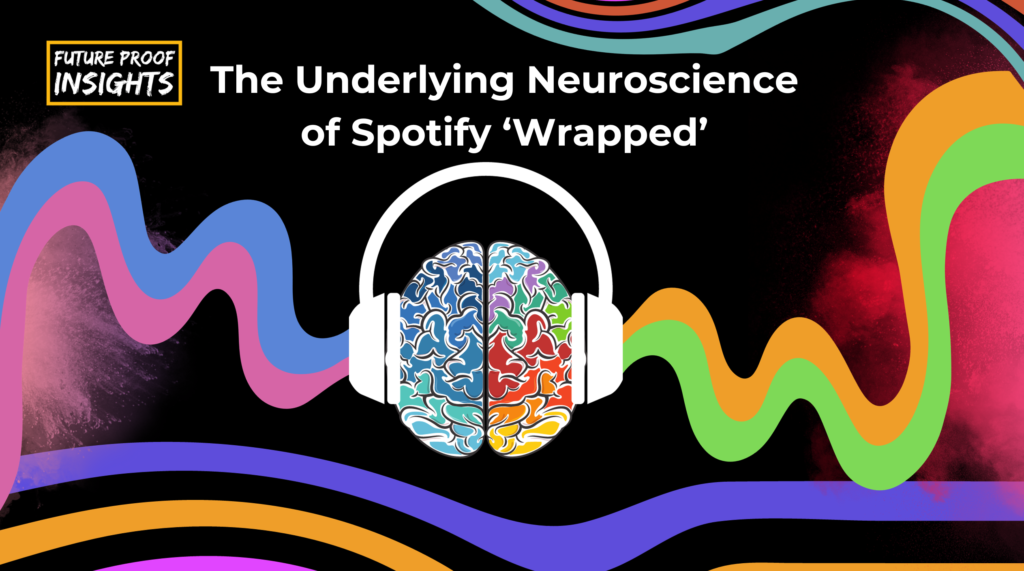As we navigate and embrace the intricate world of technology and its intersection with our day-to-day lives, we often find ourselves captivated or even ‘hooked’ by events off all types, where the technology consumes our attention. These events could happen yearly, monthly, daily, sometimes hourly!
One such phenomenon is Spotify’s “Wrapped” feature, which has garnered immense popularity for its insightful and engaging presentation of our yearly music habits! Spotify users have come to expect and anticipate their own personalised “Year in Review”, revelling in the nuggets of information on offer. But have you ever asked yourself what makes this feature so appealing and successful? The answer lies not just in the design or the library of music, but also in the circuitry and networks of our brain.
Let’s delve into neurocognition to understand and unveil the secrets behind the success of Spotify’s “Yearly Wrapped”.
“Spotify’s “Wrapped” feature is not just a feature but a neurocognitive adventure that resonates with us on multiple levels. It is an intriguing interplay of music, technology, and the human brain. The blend of personalization, social connectivity, and introspection, is able to engage our brains in a cognitive experience that links to our desire for self-discovery and empathetic connections in the digital age.” – Jeison Parra Tijaro PhD., Head of Neuroscience, Future Proof Insights

Neurocognitive Engagement through Personalisation:
Our brain’s inclination towards stimuli that hold personal relevance is a cornerstone of the appeal of Spotify “Wrapped”. Personalising digital experiences not only captures our attention but also actively engages crucial areas of the brain involved in self-reflection and memory.
This engagement might involve reflection and memory retrieval! Activating areas such as the medial prefrontal cortex (mPFC), which is linked to self-referential thinking and memory. The presentation of the ‘Wrapped’ feature activates the visual cortex and some midbrain activations, therefore generating a holistic emotional experience, all happening directly in the user’s brain.
Speaking about the work they do at Future Proof Insights, MD Seán Higgins said “We spend a lot of our time at Future Proof investigating non-traditional experiences, to help clients understand why they are so impactful, allowing them to tap into the underlying principles of neuroscience, so that they can move the needle for their brands in meaningful ways. Spotify’s Wrapped contains a huge number of valuable insights into how you can drive consumer behaviour.”
Additionally, “Wrapped” supports the sharing of this music habits as an extension or representation of our preferences. The act of sharing our musical year with others isn’t just a social gesture, it is much more meaningful. Understanding how this sharing activates our mirror neuron system reveals so much about the social fabric of our digital interactions and the profound sense of belonging they can create.
The brain’s reward system and dopaminergic areas get activated as music is rewarding itself, therefore, structures like the ventral striatum, is activated when sharing something that reflects personal identity, like music tastes and empathising with others.
“With Wrapped, Spotify have cleverly achieved a deep level of connection with the user that reflects a person’s own identity, whilst also generating a desire for sharing. By understanding the neural mechanisms underpinning the Wrapped feature, brands can lean into these concepts in their own to drive connection with consumers, users, and shoppers.” – Seán Higgins, MD, Future Proof Insights
On a different note, “Wrapped” also creates a journey of introspection, highlighting the role of the ‘default mode network’ (DMN) in our brains. This journey is not just about music; it’s a narrative of our identity and experiences woven through the year, and the music is the sound and vibe that mark our neural pathways. The DMN is active during introspective activities like daydreaming, recalling memories, and thinking about the future. It plays a crucial role in building a sense of self and continuity over time. Spotify’s “Wrapped” feature cleverly prompts users to reflect on their past experiences and preferences, reinforcing their musical identity and self-concept.






